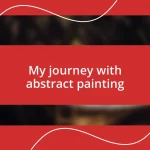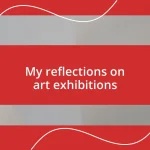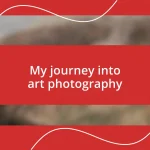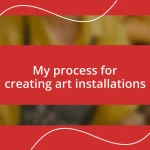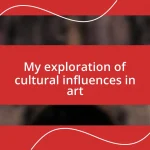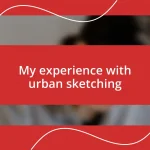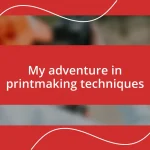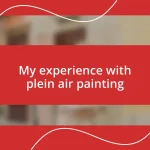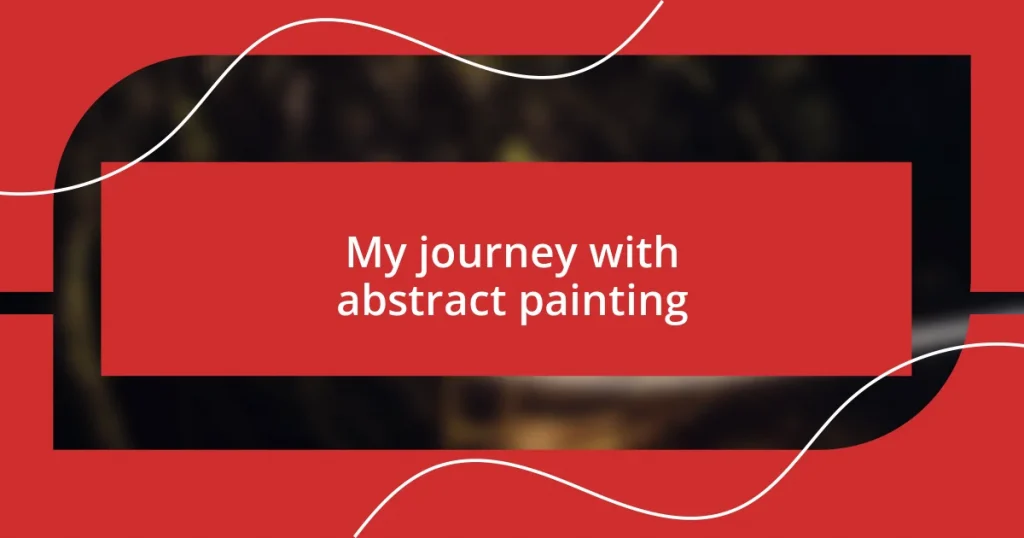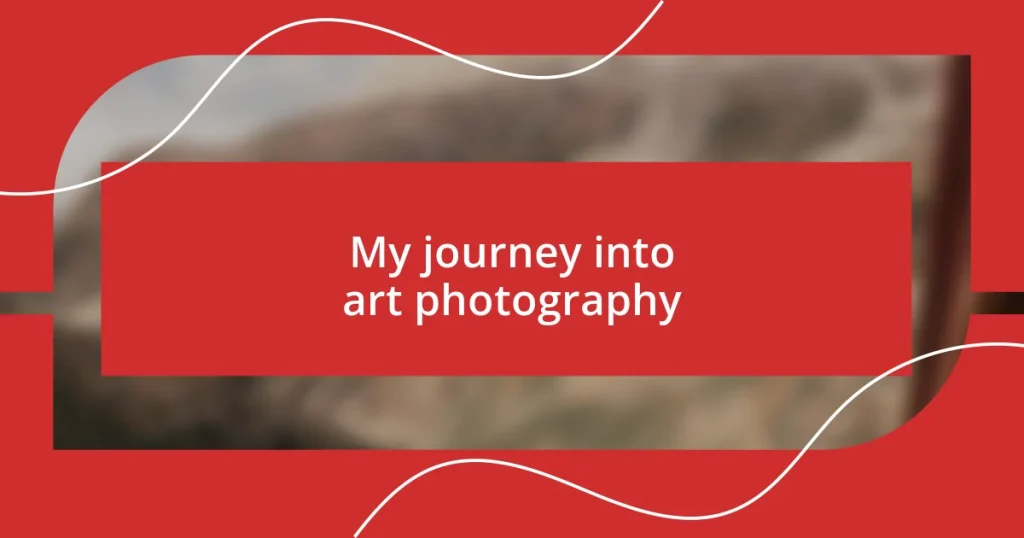Key takeaways:
- The author discovers the emotional power of abstract painting through personal interpretation and experimentation, highlighting its ability to evoke deep feelings.
- Key techniques like pouring and layering paint contribute to the spontaneous and textural elements of abstract art, emphasizing the importance of intuition and embracing chaos.
- Lessons learned include the value of imperfection, emotional connection, and patience in the creative process, transforming perceived mistakes into vibrant artworks.
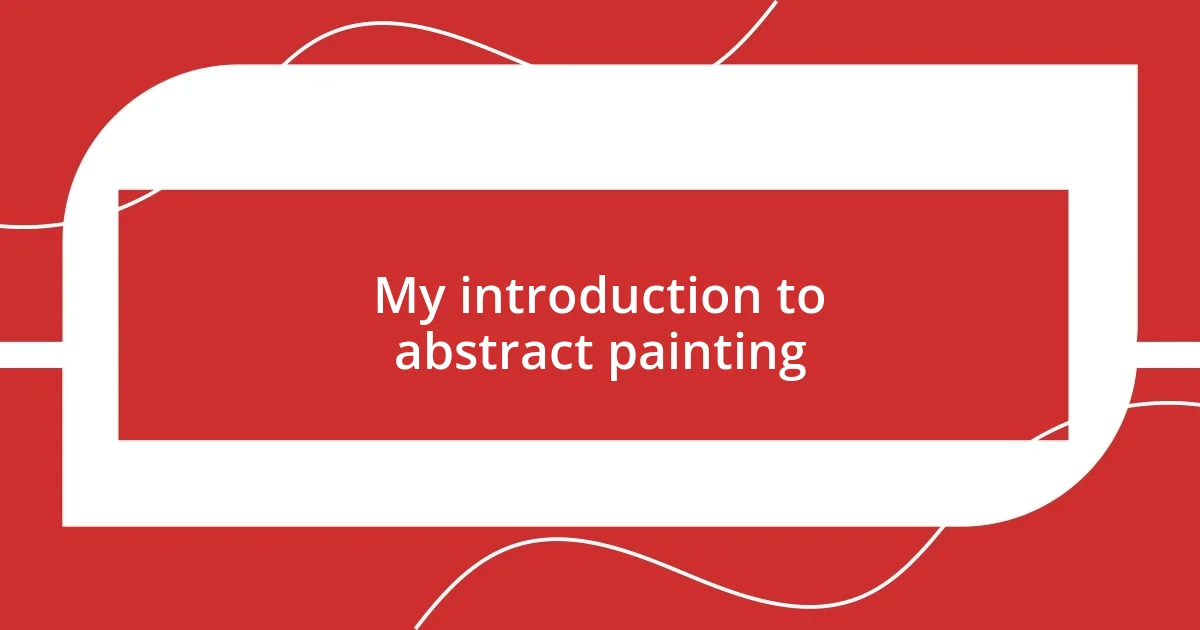
My introduction to abstract painting
I still remember the first time I stumbled upon abstract painting at a local gallery. The colors seemed to dance across the canvas, pulling me in with such energy that I felt a rush of emotions I couldn’t quite explain. What was it about these shapes and splashes that connected with me on a deeper level?
As I explored more in the realm of abstraction, I found myself experimenting with my own interpretations. I remember one afternoon, stepping into my tiny studio, feeling overwhelmed yet exhilarated, not knowing where to start. It was in the messy spontaneity of those early attempts that I began to tap into my true emotions, allowing the paint to flow freely and reflecting my inner world in vibrant hues.
Reflecting on that journey, I often ask myself how abstract art can evoke such powerful feelings. For me, it becomes a mirror of my thoughts and emotions—something raw and unfiltered that invites viewers to connect with their own interpretations. It’s fascinating how a simple stroke or color choice can open up endless conversations, isn’t it?
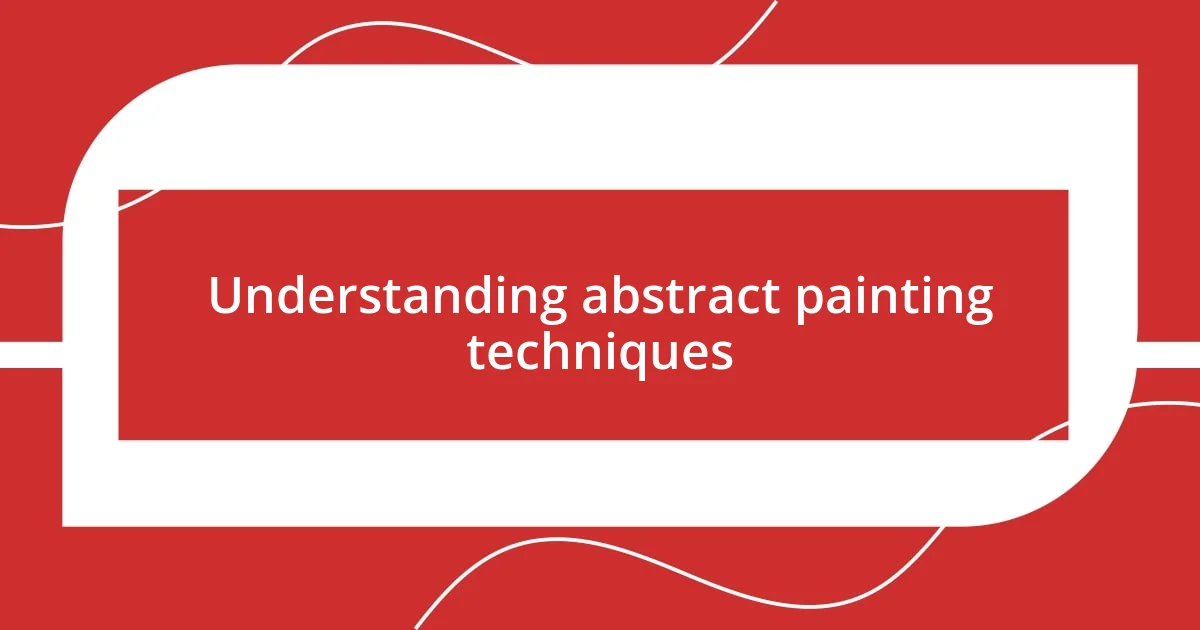
Understanding abstract painting techniques
Abstract painting techniques can vary widely, but at their core, many revolve around the idea of expressing feelings rather than depicting reality. I’ve often found that using bold colors and dynamic shapes can evoke a sense of movement. One day, while adding layer upon layer of paint, I discovered the joy of letting my intuition guide me; it transformed each stroke into a profound connection to my emotions.
One of my favorite techniques involves pouring paint onto the canvas—a method that feels as liberating as it is unpredictable. I recall one evening, when I allowed gravity to play its part in my creation. Watching the colors blend and cascade was a reminder that sometimes, embracing chaos can lead to beautiful outcomes. Embracing this technique has taught me to let go of control and trust the process.
When considering texture, layering techniques can add a tactile dimension to the artwork. My experiments with various tools, like palette knives or old credit cards, have led to intriguing results. Each scratch and smear tells its story, enriching the work and inviting viewers to explore its depths. I often wonder how my own experiences shape the textures in my paintings—there’s a certain catharsis in allowing my journey to emerge through layers.
| Technique | Description |
|---|---|
| Pouring | Pouring paint onto the canvas, creating a fluid and dynamic composition. |
| Layering | Building layers of paint for texture and depth, often using tools for various effects. |
| Color Blocking | Creating distinct sections of color to convey emotions or themes. |
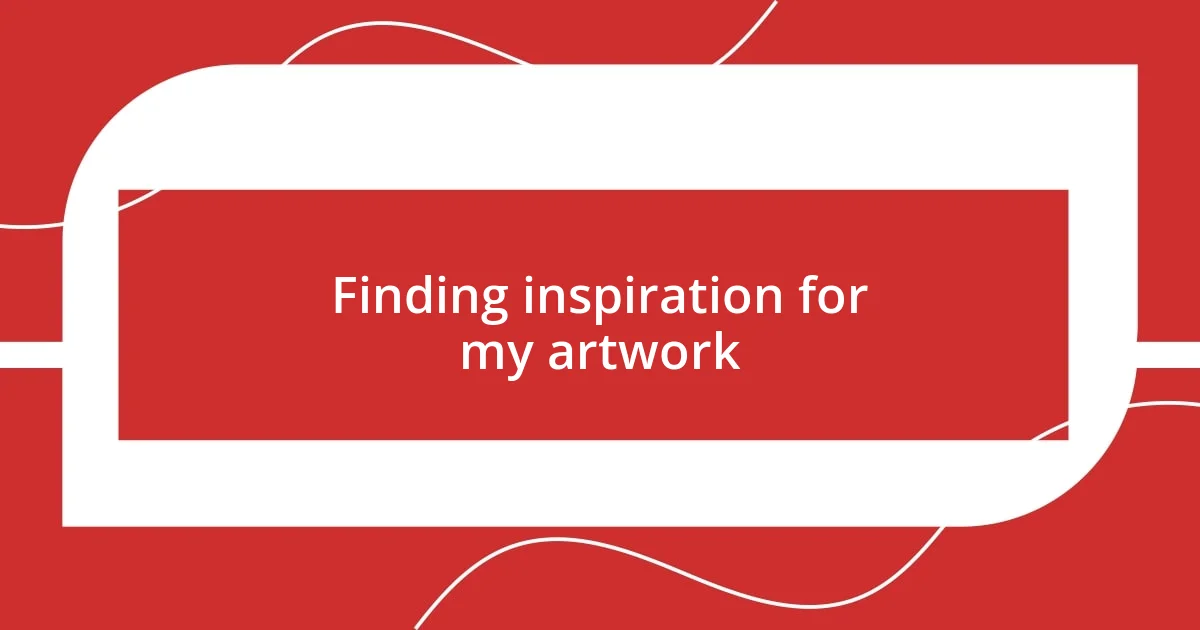
Finding inspiration for my artwork
Finding inspiration for my artwork is often like chasing shadows—elusive yet captivating. I draw from everyday experiences, which sometimes yield the most profound insights. For instance, during a walk through my neighborhood, I once watched the sun set, casting vibrant hues of orange and pink across the sky. The moment made me realize how light and color interact in nature, sparking a flurry of ideas for my next canvas.
To harness this inspiration, I often turn to:
- Nature: The changing seasons and landscapes continuously fuel my creativity.
- Music: Certain melodies resonate with my emotions, often guiding my brushstrokes.
- Personal Memories: Specific experiences—like laughter shared with friends or quiet moments of solitude—infuse my work with emotional depth.
- Art History: Exploring past artists’ techniques allows me to connect their visions with my own unique perspective.
- Everyday Life: Simple interactions, from a meaningful conversation to observing a child’s uninhibited play, provide rich inspiration.
In essence, inspiration finds me when I remain open and attuned to the world around me. Whether through the rustling leaves or a fleeting thought, I learn that creativity shows up in the most unexpected places.
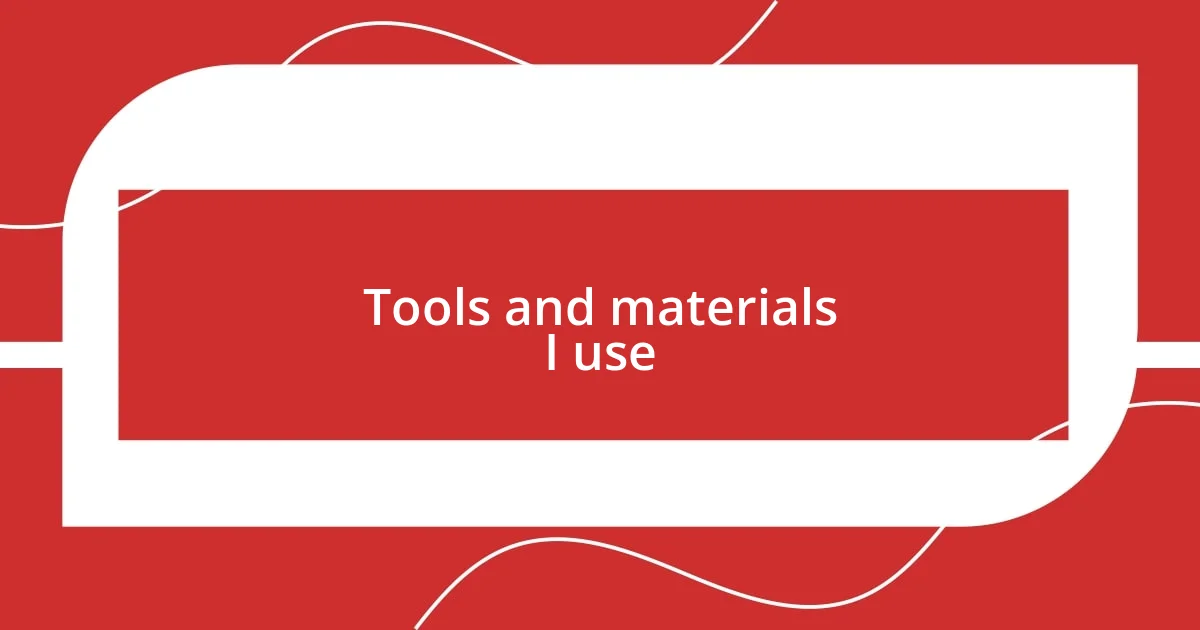
Tools and materials I use
When it comes to the tools and materials I use for abstract painting, I have my favorites that I can’t live without. My go-to brushes range from large, flat brushes for sweeping strokes to fine-tipped ones for detail work. Each brush has a personality, and I sometimes find myself chatting with them as I paint—do you ever feel that connection with your tools? It’s a fascinating relationship, and the right brush can truly elevate the emotion I want to convey.
Beyond brushes, I absolutely love working with acrylic paints. Their vibrant colors and fast drying time allow me to layer without waiting too long. One day, I mixed a bold teal with a hint of gold, and the resulting hue became the star of my piece. It was mesmerizing to see how that single mixture transformed the canvas—have you ever experienced a color that seemed to speak to you? The magic of color is an adventure in itself.
Texture is another essential element in my work, and for that, I often use everyday items like sponges, rags, and even my fingers. I remember a painting session where I experimented with a crumpled piece of plastic wrap. When I lifted it off the canvas, the unexpected patterns it left behind were exhilarating! It got me thinking—what innovative textures could you introduce to your artwork? Embracing unconventional materials not only adds depth to my pieces but also infuses them with stories waiting to be discovered.
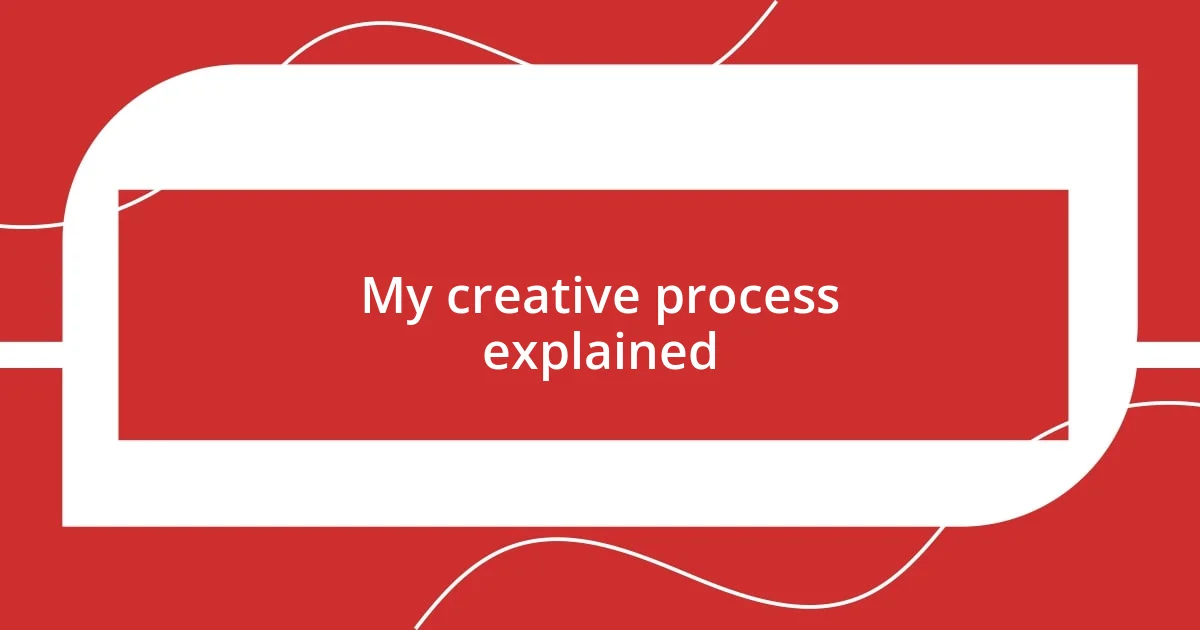
My creative process explained
Explaining my creative process is like peeling an onion—layer by layer, there’s so much to discover. I often begin with a blank canvas and a clear intention, but surprisingly, what emerges often deviates from my original plan. During one session, I started painting with a specific theme in mind, but as I mixed colors and let my emotions guide me, an entirely different image blossomed. Have you ever had a project take a turn you didn’t anticipate? Those moments remind me that surrendering to the process can lead to unexpected beauty.
As I paint, music plays an integral role in shaping my creative flow. I recall a day when a soft piano melody stirred something deep within me. I felt compelled to use sweeping movements, capturing the emotions the music evoked. Have you experienced how a tune can transform your perspective? For me, it’s like entering a dialogue between the sound and my brush, where each note guides my hand and the painting evolves in harmony with the rhythm.
Ultimately, reflection becomes an essential part of my process. Once I finish a piece, I take a step back, allowing the colors and shapes to speak to me. I remember one painting that I initially disliked, feeling it lacked cohesion. After some meditation on it, I discovered hidden narratives within the chaos. Isn’t it amazing how our perception can shift? Taking the time to reflect often reveals layers of meaning that I wasn’t initially aware of, deepening my connection to each artwork.
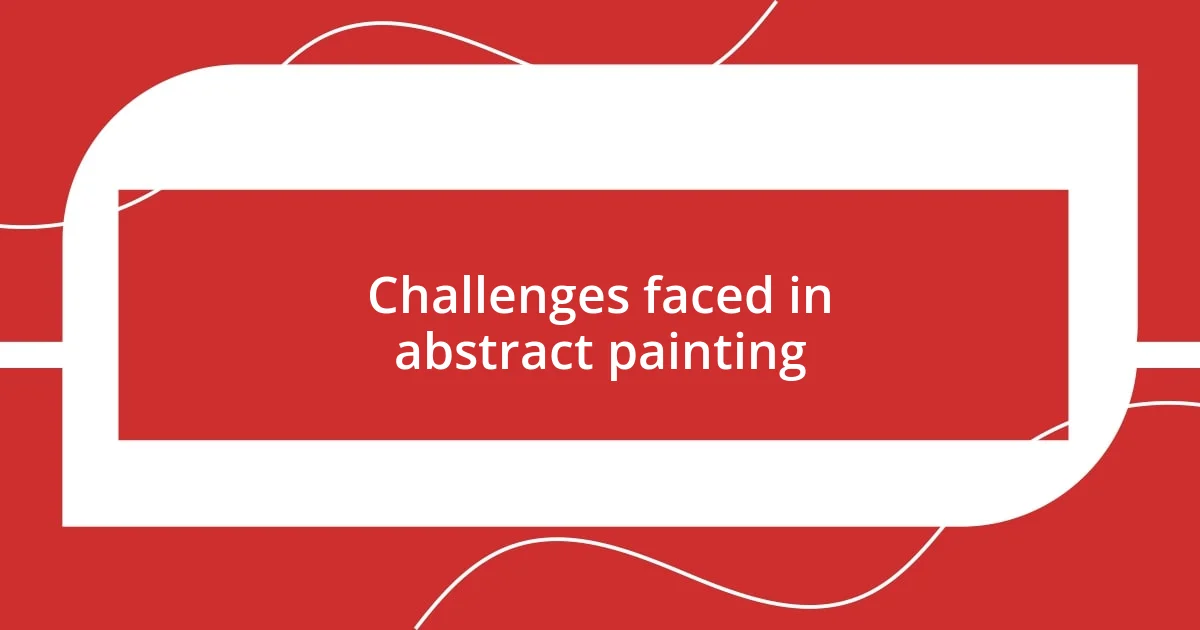
Challenges faced in abstract painting
Engaging with abstract painting is undeniably rewarding, but it comes with its fair share of challenges. One of the most significant hurdles I often encounter is overcoming the fear of experimentation. There have been countless moments when I hesitated to mix an unusual color or use an unconventional technique, worried it wouldn’t turn out as I imagined. Have you ever felt that tension between wanting to push boundaries and the safety of sticking to what you know? I’ve learned that stepping outside my comfort zone is where the true magic happens, but it’s a leap I still find daunting.
Another challenge lies in interpreting emotions on the canvas. Abstract painting is often about expressing feelings in a non-literal way, and that can be tricky. I vividly recall a day filled with frustration and confusion. I sat down to paint, hoping to convey my turmoil, but the colors felt flat and uninspired. It was a true test of my ability to translate emotions into visual form. Have you ever struggled to articulate what you’re feeling? It’s moments like these that remind me that patience is key, and sometimes I need to let my brush move freely to uncover the underlying emotions waiting to be expressed.
Lastly, I frequently grapple with the notion of completion. When is a painting truly finished? There are times when I’ve walked away from a piece, only to return later with the urge to add just one more stroke or splash of color. Recently, I found myself staring at a canvas for days, questioning if I should rework it or if it was perfect in its imperfection. Do you ever obsess over the details, wondering if they’re enough? I’ve come to realize that embracing that uncertainty can be part of the journey, and sometimes, the art’s soul shines brightest when it feels just a bit unresolved.
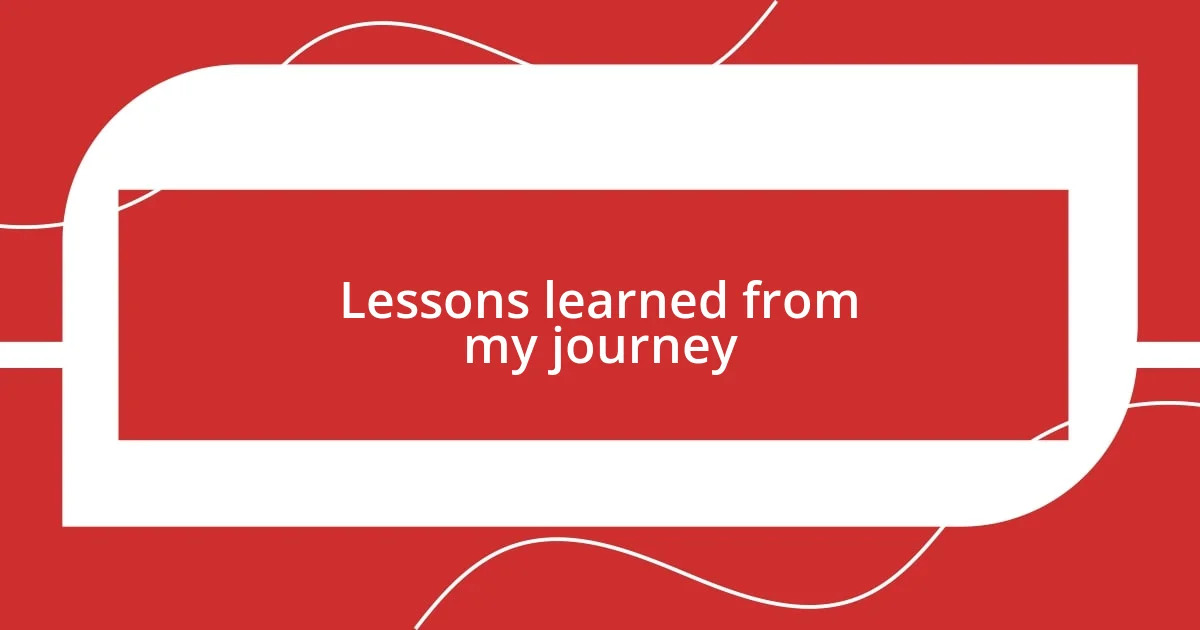
Lessons learned from my journey
One of the most profound lessons I’ve learned from my journey in abstract painting is the importance of embracing imperfection. Early on, I created a piece that I believed was a complete failure. I remember standing in front of it, frustrated and ready to give up. But instead of walking away, I decided to add a few spontaneous brush strokes. Those final touches transformed the artwork into something vibrant and unexpected. Have you ever found beauty in what you once considered a mistake?
I’ve also realized how vital it is to connect with my emotions while painting. There was a day when I felt an overwhelming sense of joy, and I let that feeling guide my brush. The colors danced on the canvas, each swirl reflecting my mood. It taught me that our emotions can be a powerful source of inspiration. Can you recall a moment when you channeled your feelings into a creative outlet? Leaning into that connection has often led to my most authentic pieces.
Lastly, I’ve discovered that patience is an essential ingredient in the artistry of abstract painting. I vividly remember spending weeks on a single canvas, layering colors and techniques, only to feel like it wasn’t quite right. Instead of rushing to finish, I took the time to revisit my work, allowing it to evolve naturally. Have you ever let a project breathe before declaring it complete? That process of patience not only cultivates growth but also enhances the depth and meaning of the final piece. Every layer tells a story, and sometimes pausing to reflect can lead to deeper insights.
